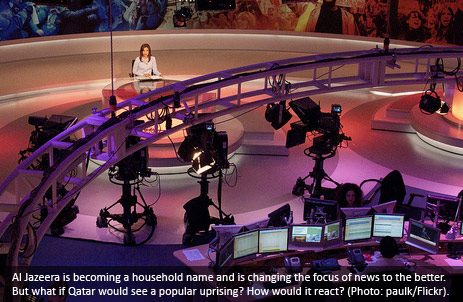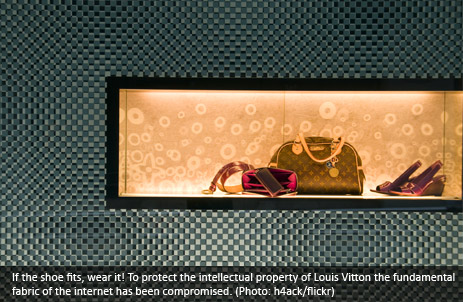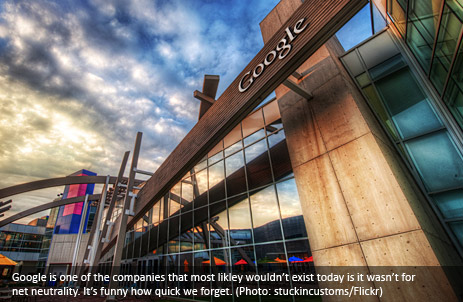In several articles I’ve briefly commented on the fact that there is a problem – from a democratic point-of-view – with how Internet access is being sold to consumers today. The technology used does not encourage what I believe is promoting the fundamental uniqueness of computer mediated distribution. This article is an attempt to elaborate on the subject – hopefully, so that even non-geeks can grasp at least some of it.
Is There a Problem With Technology?
A truism of network-building is that the most difficult part of offering high speed internet is not building the backbone, but getting transporting the signals the last two kilometers from the provider and into the homes of consumers.
Today, broadband Internet connectivity is sold to consumers in a few basic flavors: ADSL, Cable and fiber. Fiber is rare, and globally the real competition is between ADSL and Cable – what method is most common depends on what country you look at. In the US for example, cable access is more common than ADSL while in Sweden it’s the other way around.
ADSL, as the most common variant of xDSL-technologies are called, is in theory a superb way of hooking people up to the Internet. It allows for telco’s to connect their telephone station to the backbone, and then use the existing copper wire to reach in to peoples homes. This means no modifications to the building, nor to each and every apartment. It’s simply plug-and-play from the consumers point-of-view. (Today, ADSL also comes in two modified (and thus faster) versions: ADSL2 and ADSL2+. These will be treated synonymously with ADSL in this article.)
Cable is also cheap because the infrastructure is (mostly) already there. The medium used is the coax cables that ordinarily carry television broadcasts.
Fiber, on the other hand, is extremely fast and future proof, but seldom a realistic possibility. Each apartment building needs to be directly hooked up with dedicated fiber cables, routers have to be installed in the basement, and ethernet network cables be installed in every apartment. In effect, very few households have fiber-access, in comparison to ADSL and cable.
Now to the design flaw: ADSL and cable is asymmetrical, a fancy word for saying that the speed at which you can send data and the speed you can receive data, is not the same. For example, personally I have a connection that is called 8/1 – in other words, I can receive at 8 megabit per second (mbps) and transmit at 1 mbps.
In Sweden, the country I’m for obvious reasons most acquainted with, the ISP’s are franticly competing to offer high speeds at very low cost using ADSL-technology. Last I checked, 24 mbps cost SEK 399/month (about US$60/month) from Bredbandsbolaget. So, what’s bad about that? Well, nothing if you don’t consider that the connection they’re talking about is a 24/1 mbps service – offering only 1 mbps of upload.
Why Is Up-Speed Important?
What separates the Internet from other media is that the audiences are active in participating as senders – just not being passive recipients. Radio, television and print media – they’ve all been a way for consumers to receive, but there was no way to transmit or respond to the messages. Networking changed all that, and I dare to say that this reason alone is the reason why the Internet is so extremely popular. All the “killer-apps” we’ve seen is because of a feedback channel; e-mail, Internet banking – even simple web browsing is interactive. But what also changed was that everyone could become a sender in a more revolutionizing way – setting up homepages and transmit material in a way that more resembled newspapers than anything else. (Remember the homepage-craze in 1995? Everyone had one, though nobody admits it today.)
Without the decentralized structure of the Internet – that anybody could publish content anywhere – there’d be no Internet. Not by definition, not in practice. The closed computer networks that attracted consumers 15 years ago (most notably America Online, CompuServe and Prodigy) died or were forced to become open systems within about five seconds after the Internet gained momentum. There simply was no way a single company could envision or create such the diversity of services offered on the Internet. (Some wise-guy will comment that it had to do with availability of pornography – but even so it does not contradict my theory. It still had to do with people being able to broadcast material, whether its pictures of last years Christmas celebration with the family or pictures of people with absolutely no costumes on.)
So, I argue that the reason for the Internets success is that it allowed people to express themselves. And for that an uplink channel is needed. A concrete example of what I mean is this very blog you are reading now. It’s hosted on a crappy second-hand computer I bought for SEK 1000 (about US$140) and is standing in a closet in my apartment. Using the Internet and its inherent channel to transmit information I’ve transformed a closet into a broadcasting device with a (potentially) global audience.
My fear, however, is that the possibility of transmitting is being effectively removed by current standards, endorsed by the owners of the networks. Why you ask? Because of a flawed technology, coupled with greed from the ISP’s to make money with content services.
Is There a Problem With the Companies?
For a capitalist, the ultimate goal is consumer addiction. This is a wet dream for them because nothing is as good as a costumer that returns again and again – without money having to be spent on persuading him to do so. Short of getting people addicted by their own free will, they can at least take every precaution that people don’t have a choice.
Thus, companies strive – in one way or another – towards creating virtual monopolies. They want to have an exclusive channel into your brain without the hassle of competition. For this reason, many media companies have merged in the last decades, to create huge conglomerates that, for example, control the whole chain of production, distribution and advertisement of a movie. It makes sense to them. Very much sense, actually. Not only do they produce the movie, but also they can make absolutely sure you see it, whether you want to or not.
So what on earth has this got to do with broadband Internet? Well, Time Warner owns Road Runner, one of the biggest providers in the US, for example. All Internet service providers, trying to maximize income, see huge possibilities in controlling content – not setting it free.
The asymmetric model being built into technology fits the companies perfectly, since they want passive consumers who are in need of content. Even though there are alternative technologies, such as VSDL, capable of offering symmetric bandwidth, ISP’s often chose not to pursuit them, and where they existed have discontinued them – at least in Sweden.
A recent Swedish example can illustrate my point. As the available bandwidth to the consumer increase so does the opportunities to send services their way. IP-telephony (or VOIP) has been around for a while, and for consumers it is a fantastic way to lower their cost for national and international telephony. Since they already have the bandwidth they can just sign up to any service and make really cheap phone calls. Well, for customers of Bredbandsbolaget it’s not quite that easy. Since they offer their own VOIP-service and do not wish to have competition, they’ve simply blocked the use of other services, and thus limiting the bits allowed to freely pass through the line for which the consumer is paying.
The same pattern is repeated with the launch of broadband broadcasted television that was launched by Bredbandsbolaget in cooperation with Viasat – Sweden’s largest satellite-TV owner. At the cost of 5 Mbps and a mere SEK 299/month you get 27 tv-channels blasted right into your TV. (What they fail to mention is that it’s just as expensive as their non-broadband packet, and then you get to keep your 5 Mbps – why can’t really see the use just yet?)
Instead of separating the infrastructure from the content, the two are increasingly intertwined. The promise of broadband distribution is that you should be able to buy television, in the form of zeroes and ones, from just about anybody. Not just repackaging an old service digitally and selling to you again. What this leaves us with is the monopolies the cable companies created in the 80’s – effectively controlling what was broadcasted to the homes. They owned the cables and operated the service. Where are the competition were did my free choice go?
The Future of the Network
The problem with this approach is that it’s counter-productive for the prosperity of the Internet as a growing community. Again, consider what the lessons from the early 90’s taught us – closed networks perish because they are not really networks of independent nodes but a controlled and centralized environment. I repeat what I said above: Without the decentralized structure of the Internet – that anybody could publish content anywhere – there’d be no Internet. Not by definition, not in practice.
I believe that in order to satisfy the increasing demands of bandwidth, as services get more complex and more mission-critical, P2P-technology (also called peer-to-peer) will become a vital part of the distribution chain. And I’m not talking about Napster or eDonkey but about a transparent system that distribute content by letting the computers organize themselves to minimize strain on the network and enable lightning-fast transfers. The business models of copyright holders and content providers will have to adjust to such a system in order for the companies to survive (…but that’s another article).
Already today there are systems, based on P2P, that allow people to download media content, released under a less restrictive license. Torrentocracy is one of them that I mentioned in an article just the other day.
Even the, usually pretty business-conservative paper, The Economist admits (subscription walled) that utilizing P2P-technology is a natural development and would enable faster, better and more fault-redundant services to the consumers. Creating a hub-and-spokes-network as what largely done today is not ideal, they say.
The problem is that P2P will only work if the nodes in the network are symmetrically hooked-up. If users consume (receive) faster that they produce (send) the scheme will fail, since P2P is mathematically a zero-sum game. By definition, every bit you download has to be uploaded by someone else.
Effects for Democracy
To speak bluntly; most companies that sell Internet capacity to you today does not want you to distribute content – they’d much rather sell it to you themselves. They want you to be passive because that gives them opportunity to sell you things, while not changing their tried-and-tested business-model. Content owners need to thoroughly revise their business model for a digital age, where scarcity is no longer determining the value of commodities. Bits are not atoms.
I fear continuing on this path of turning the Internet to yet another place where you passively consume (televised) messages will indeed hurt the Internets inherently democratic effects of allowing its participants to have a voice. P2P could enable ordinary citizens to distribute their own content, much like what bloggers all over the world are doing with ideas right now. Participation is the cornerstone of a healthy democracy, and the mainstream media have failed to be inclusive enough – by any standard.
The question is of course if governments should regulate Internet connectivity and treat it like a public commodity. Critics to such an idea usually claim that the Internets success is to a great deal the story of entrepreneurs and that therefore it’d be wrong to regulate. However, one should also keep in mind that the Internet is the result of millions of dollars spent on research – funded by the US government. So, maybe we should cut the governments some slack? Besides, nobody at their right mind is talking about expropriation of the Internet, just some guidelines for what is acceptable behavior. Like what FCC in the US (and PTS in Sweden) do for telecommunications.
Somebody said that we often overestimate the progress that will be made in two years, but underestimate what will happen in ten. To me, that is both good and bad news given this scenario. For one, the technologies we see today are not what are going to be still here in ten years. Bandwidth demand will continue to increase, and I’d expect them to level out at about 1 Gbps per household (I’m not kidding). However, one should still be mindful of the things I’ve explored in this article. Structures and patterns of behavior are determined at an early stage, even though unsymmetric technologies get replaced, we might have gotten used to just downloading the last 40 seasons of Friends from our old buddy the cable company.
(Thanks to Mark for a great discussion on the matter.)



